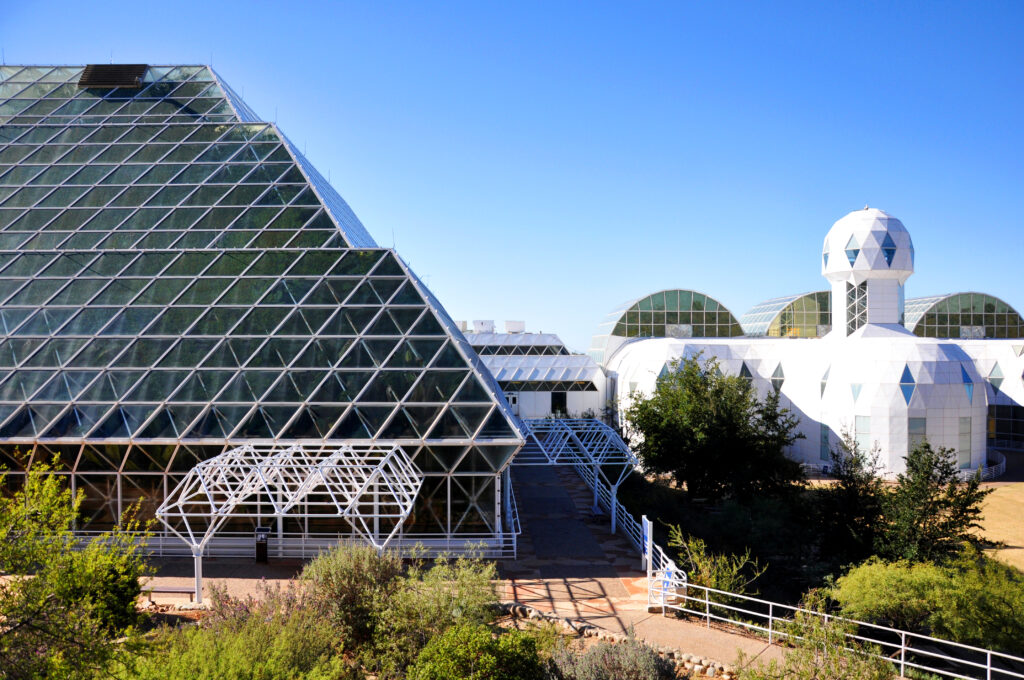
The Biosphere 2 Center in Oracle, Arizona. Photo by Michael Aaron Gallagher, taken in 2019.
The Biosphere 2 Center: Loss of Biodiversity Within the Marsh Biome (Mangrove Estuary)
By Michael Aaron Gallagher
Originally published in Syracuse University’s Intertext Vol. 10, where it received honorable mention for the Louise Wetherbee Phelps Award.
Update: October 17, 2019 – After 21 years, I had the opportunity to return to the Biosphere 2 Center, once again stepping foot inside one of the most extraordinary research facilities on the planet. The following white paper was originally published in 2002 in Intertext Vol. 10 at Syracuse University, based on my experiences inside the Center with Columbia University’s Earth Systems Field School in 1998. (I have moved the reactions from my professor and the editor of the publication to the end of the paper, but the piece itself remains largely unedited and unrevised, except for the addition of photography, which was taken on my recent return to the facility as well as original photos from 1998.)
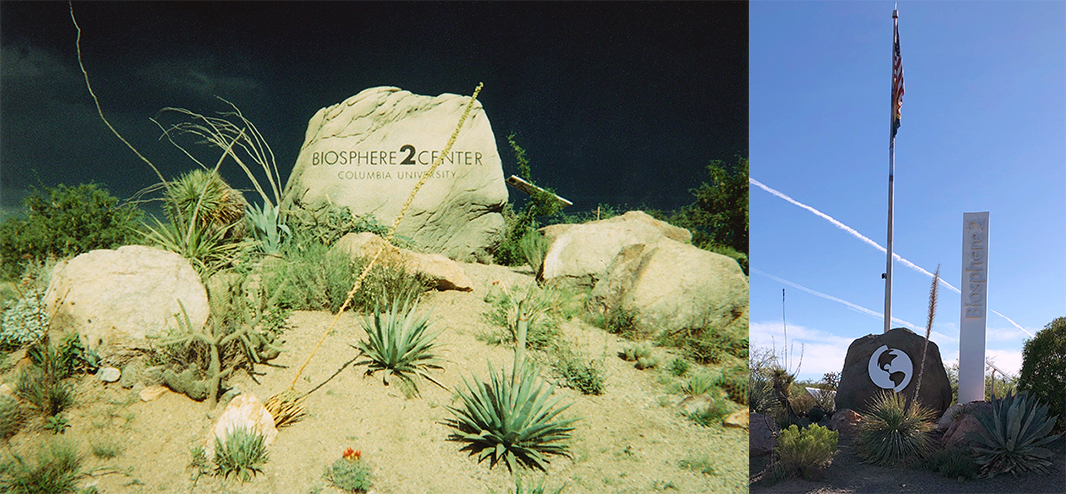
The entrance sign to the Biosphere 2 Center in 1998 when it was owned by Columbia University and in 2019, when it was owned by the University of Arizona. Photos by Michael Aaron Gallagher.
The Biosphere II Center Oracle, Arizona
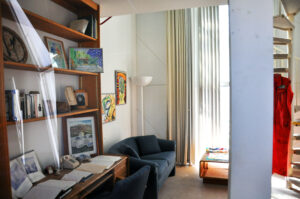
Living Quarters for the original “Biospherians.” Photo by Michael Aaron Gallagher, taken in 2019.
From the writer (written in Spring of 2002): In the early 1990s, when I first learned of the “Biospherians” and their work in Arizona, I began to dream of one day being involved in a project of that magnitude. My journey inside the Biosphere 2 Center [in 1998] allowed me to work with scientists and further my understanding of biodiversity and civilizations. When Dr. Phelps issued the white paper assignment, I was excited by the opportunity to assemble the research I had conducted and share my knowledge of an important but often ignored environmental issue.
1.0 Introduction
This white paper explores the loss of biodiversity within the Marsh Biome of Biosphere 2. The material presented provides background information on the Center itself as well as data regarding the creation of the Marsh Biome. It will then use this foundation as a starting point for analyzing the management techniques that have jeopardized the stability of the system. Using the research conducted in a 1998 study for Columbia University’s Earth Systems Field School, it will offer management corrections and improved stewardship techniques in order to demonstrate the importance of system stability and biodiversity within an artificial ecosystem.
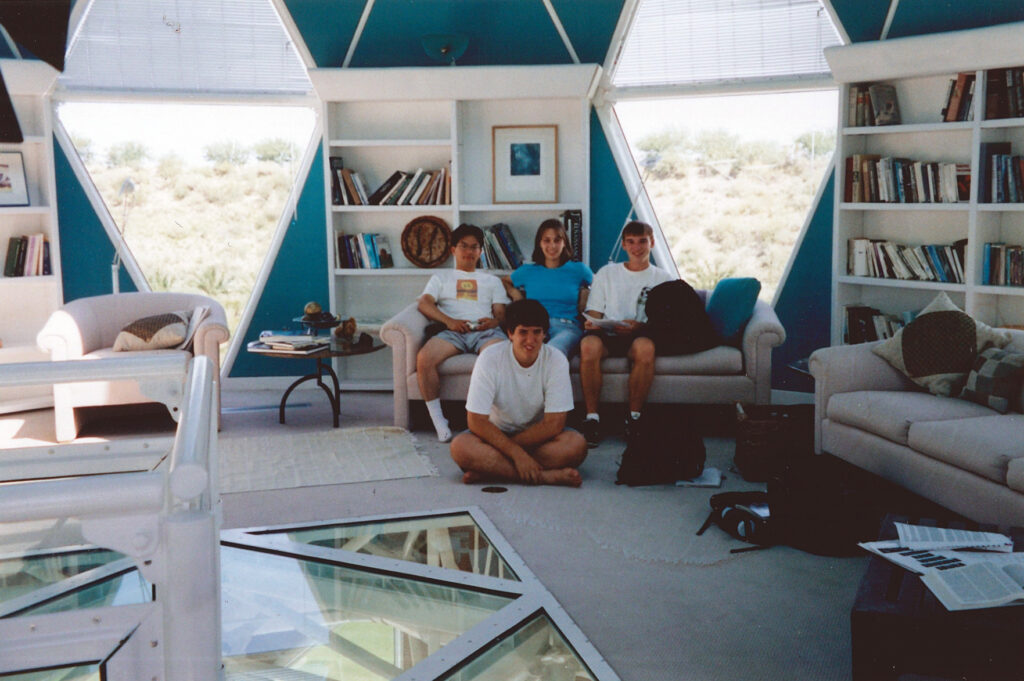
Michael Aaron Gallagher (far right) sitting next to Alexandra Vasilescu and the rest of his study group in the restricted area of the library tower inside the human habitat of the Biosphere 2 Center in 1998.
Based on research conducted in 1998, a review of the internal documents of the Biosphere 2 Center regarding species implantation, and recent developments in biome management, this white paper will examine the following:
- Key Structural Features of the Biosphere 2 Center
- Original Design of the Marsh Biome (Mangrove Estuary)
- Communication Channels and System Stability
- Research on the Loss of Biodiversity Within the Model
- Management Remedies and Stewardship
2.0 Behind Closed Doors
The History of the Center
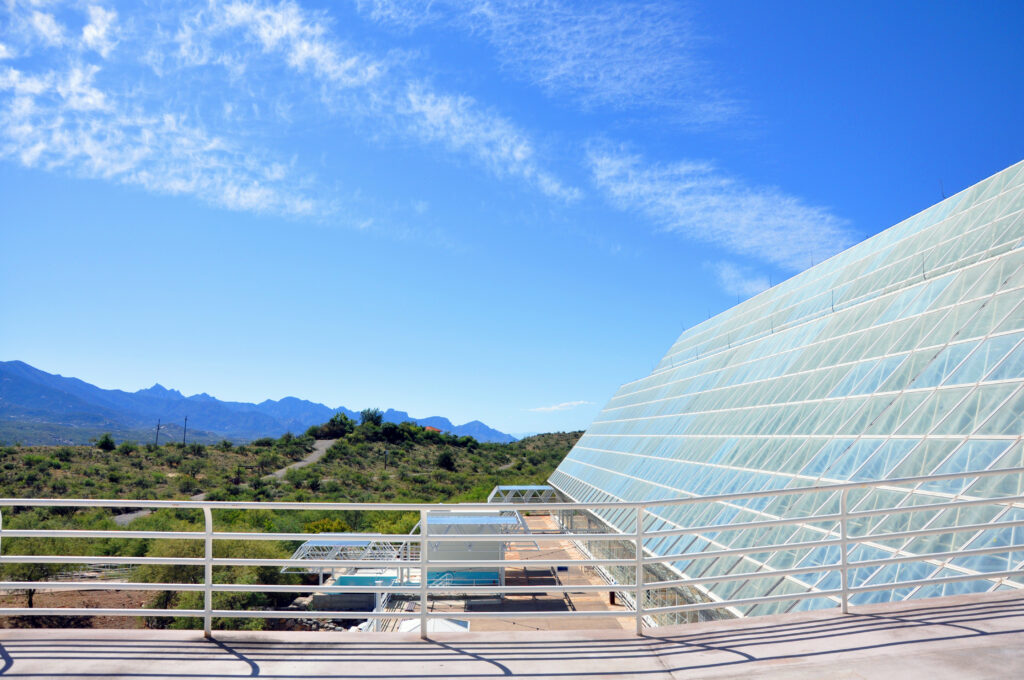
The Santa Catalina Mountains and the Biosphere 2 Center. Photo by Michael Aaron Gallagher, taken in 2019.
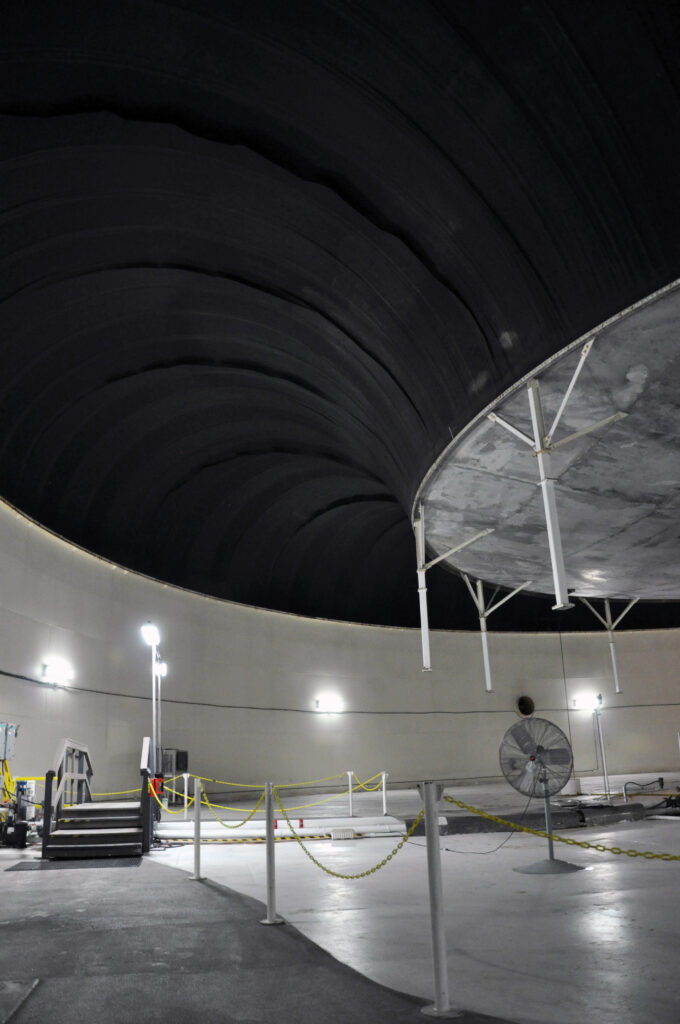
Inside one of the two lungs at the Biosphere 2 Center. The air pressure changes throughout the day as it heats and cools and the aluminum disc rises and falls accordingly. Photo by Michael Aaron Gallagher, taken in 2019.
Nestled in the Santa Catalina Mountains, the Biosphere 2 Center is located in the Sonora Desert outside of Oracle, Arizona. It was constructed in 1991 by Space Biospheres Ventures, a private scientific corporation. Amidst rumors that the project had ties to the U.S. Government, which was allegedly planning to use it as a prototype for a planetary space station, it began its operations as a controversial, top-secret facility that housed the “Biospherians.” Although the center was designed to be a self-sufficient artificial world, the spaceframe gradually became an unstable environment for human habitat. System instability was primarily a result of fluctuations in critical CO2 levels. Space Biospheres Ventures later abandoned the project, and it became a prize academic asset for Columbia University, which currently uses the Center for research and interactive study.
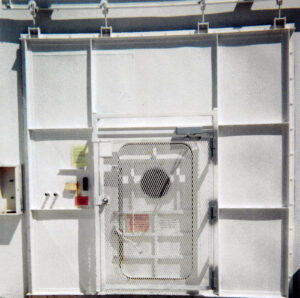
Taken in 1998, this picture shows the airlock door to the Biosphere 2 Center. With a special security pass, this was how I entered the facility. Photo by Michael Aaron Gallagher.
The Structure
The Biosphere 2 Center contains six biomes within its three-acre spaceframe. It also houses a human habitat, an interactive visitor’s center, gift shop, state-of-the-art laboratories, a habitat library, and the Command Room of Biosphere Operations. Until recently, most of the center has been inaccessible to the public.
The Six Biomes
Each of the six biomes is located within the spaceframe, allowing the Biosphere Operations Team to access data from the sensors within a particular area and simultaneously monitor critical gas levels (including CO2) and the temperature of the air and water within the spaceframe (Finn, 1). In addition to the research compiled by the biome managers, independent teams are often permitted to conduct studies within a particular area. In recent years, research and management groups have particularly favored certain biomes. As a result, others have begun to deteriorate and the stability of the entire system is being threatened.
The Marsh Biome
Of the six biomes, the subtropical estuarine ecosystem or the Marsh Biome of the Center is divided into freshwater and saltwater areas. The amount of rainfall, available light, and CO2 levels is carefully monitored from the Command Room of Biosphere Operations.
3.0 The Design of the Mangrove Estuary
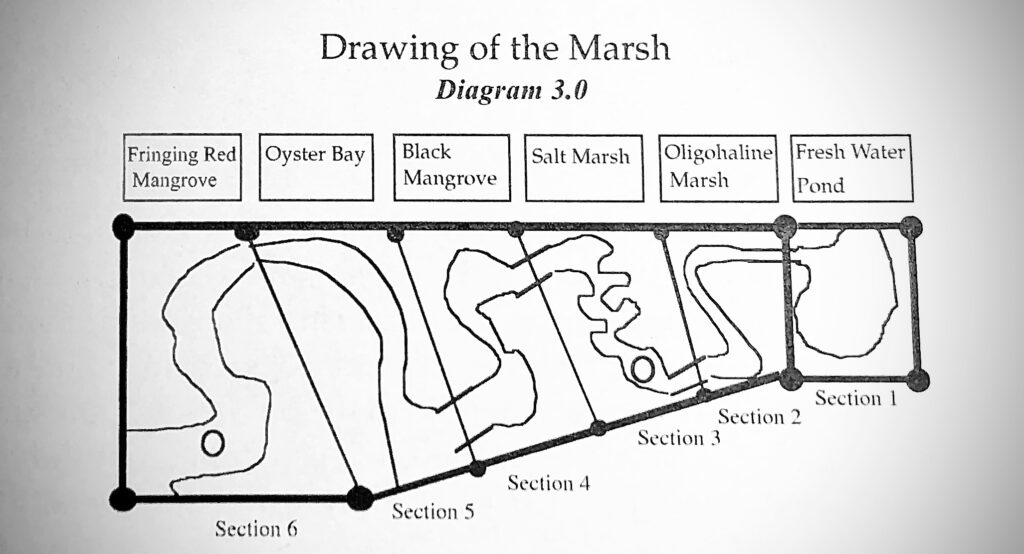
The Marsh Biome Mangrove Estuary at Biosphere 2 Center.
The Marsh Biome is subdivided into six sections. (See Diagram 3.0) Each area contains a unique display of species diversity.
3.1 Species Transplantation
When the Center was originally constructed, it was stocked with organisms and other physical matter obtained near the Everglades National Park in Florida. All of the samples were then carefully transported to Arizona (Finn, 6). The following organisms were among the more than 250 species transplanted into the marsh ecosystem: (Finn, 6)
Transplanted Organisms
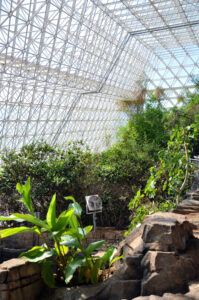
Overlooking the Marsh Biome at the Biosphere 2 Center. Photo taken by Michael Aaron Gallagher in 2019.
Mangroves
- Rhizophora mangle (Red Mangrove)
- Laguncularia racemosa (White Mangrove)
- Avicennia germinans (Black Mangrove)
Crabs
- Panopeus lacustris (Mud Crabs)
- Uca sp. (Fidler Crabs)
- Aratus pisoni (Mangrove Crabs)
Shrimp
- Mysis sp. (Fairy Shrimp)
- Alpheus heterochaelis (Snapping Shrimp)
- Palaemonetes pallidosa (Grass Shrimp)
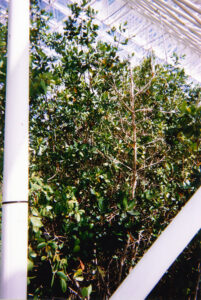
The Marsh Biome of the Biosphere 2 Center. Photo taken by Michael Aaron Gallagher in 1998.
Fish
- Gambusia affinis (Mosquito Fish)
- Lucania goodei (Bluefin Killifish)
- Jordanella floridae (Florida Flagfish)
Other Species
- Procambarus alleni (Crayfish)
- Melanoides tuberculata (Snails)
- Melampus coffeus (Coffee Snails)
- Halichondria sp. (Sponges)
- Aiptasia pallida (Anemones)
The species were not uniformly distributed across the six sections because there is a salt gradient, and many of the organisms would not be able to survive in every area. In addition to the organisms that were intentionally brought into the Center, local colonies of ants, cockroaches, and a small population of birds mysteriously emerged in the biomes. As a result, they are often observed in the Marsh even though it is not their natural habitat. Gradually, the transplanted species began to die off, and the diversity within the region suffered a noticeable decline. Certain species were able to thrive in the absence of others because of their hardy characteristics and a lack of population controls.
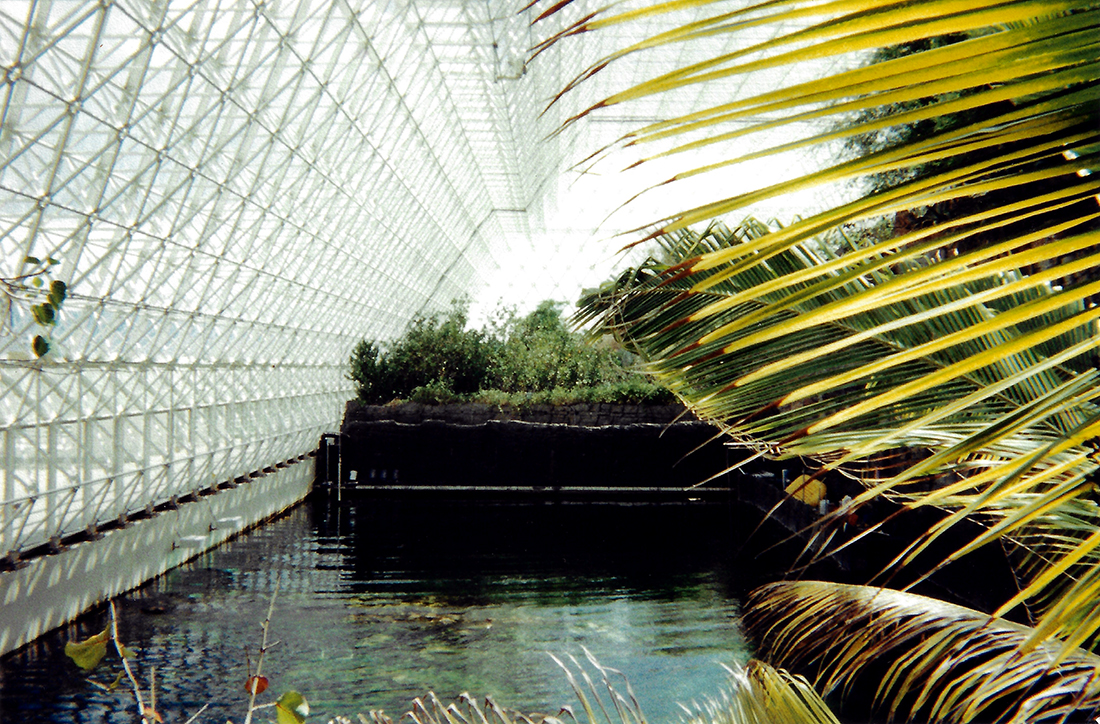
Ocean Biome in the Biosphere 2 Center in 1998. Photo by Michael Aaron Gallagher.
3.2 System Stability and Interaction
The ability of the organisms to interact with each other and the chemical reactions that form a complex web of communication between each section is limited because of the narrow gaps in the walls dividing them.
Waterflow between the areas is also limited by the design of the biome to inhibit salt-water from contaminating the freshwater regions. As a result, the freshwater pond overflows into the oligohaline marsh and moves toward the ocean, rather than away from it.
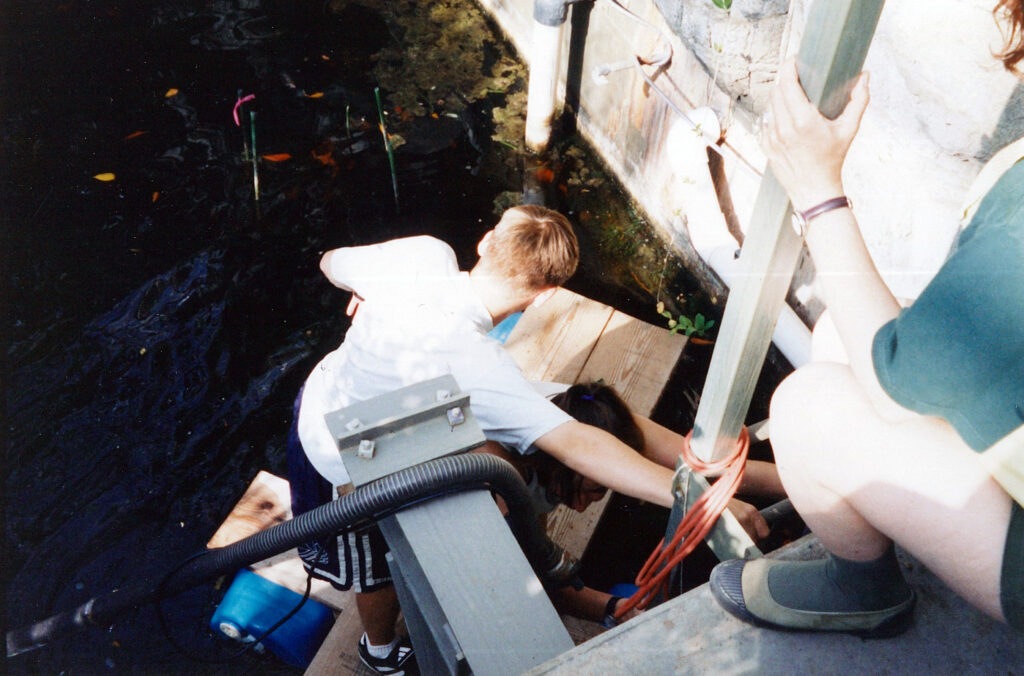
Michael Aaron Gallagher climbs onto the makeshift raft to collect data in the freshwater pond of the Marsh Biome inside the Biosphere 2 Center in 1998.
There are also several other factors that contribute to the unique structure of the artificial ecosystem. For example, other biomes are in close proximity to the Marsh, including the Desert, Savanna, and Ocean. Because of their location and a lack of distinct barriers, there may be unwanted communication or species movement in or out of the system. Not only does the presence of foreign life affect the Marsh, it can also damage the ecological health of the region. Furthermore, even the chemical composition of the water and the waterflow between sections can alter its basic characteristics.
The Study
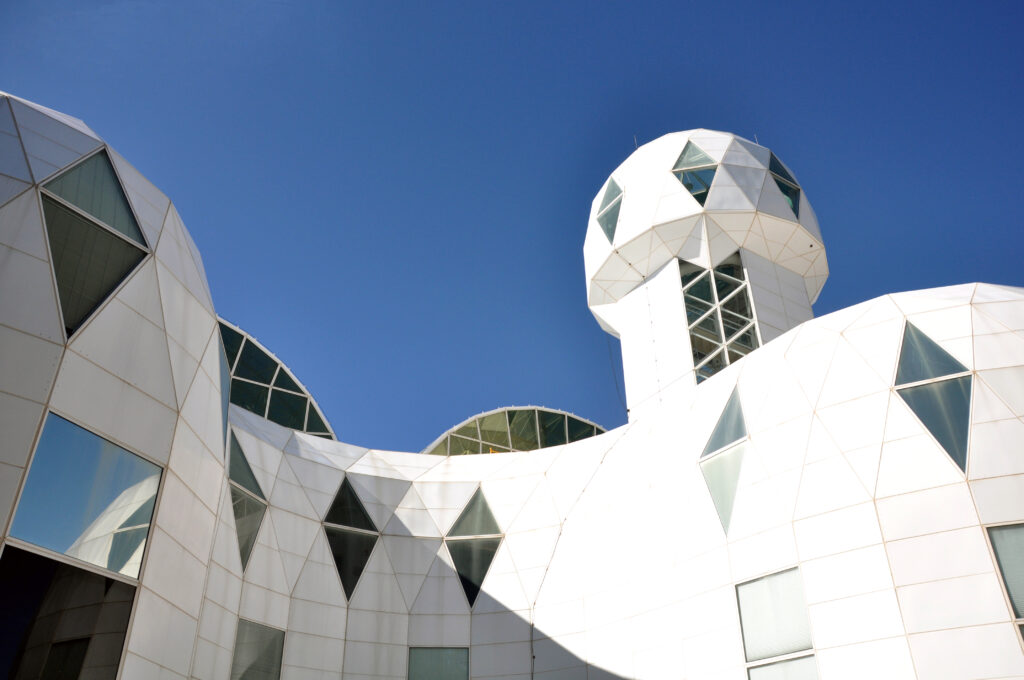
The Biosphere 2 Center library tower where some of our research was done in 1998. Photo taken by Michael Aaron Gallagher in 2019.
In 1998, a group of students in Columbia University’s Earth Systems Field School conducted a study on the Marsh Biome from inside the Biosphere 2 Center. The experiments involved collecting data in each of the six sections of the Mangrove Estuary. The group tested pH, water hardness, dissolved oxygen concentration, and collected live specimens to chart the diversity of each region. (Green, et al, 1).
A study of the six sections found that the once varied display of organisms was now greatly reduced.
There was debris including chipping paint from the spaceframe, metal construction (bolts and nuts), and natural decay from leaf fall. These could change the chemical composition of the water and thereby lead to mutations.
Mutations and deformities were present in the fish population (see figure 4.0). Disease may have been magnified by the small area and limited breeding. Several measurements were taken in each section and the dissolved oxygen concentration and pH were generally higher in the regions closer to the coral reef biome.
Water hardness was measured in each section, and the results indicated a higher level of CaCO₃ in the salt-water marshes. Although arthropods were present in the freshwater regions, crustaceans are present in a greater diversity in the salt-water marshes. Note: Their shells are made of CaCO₃, which explains the elevated levels.
It is important to remember that at the time of the study, water was being artificially circulated through the “scrubbers” in all the sections but the freshwater regions. These “scrubbers,” which lie within the Biosphere’s interior, contain both microscopic and macroscopic organisms. The water from the scrubbers is pumped into the saltwater marsh. This area contained the most abundantly diverse organisms (Green, et al 6).
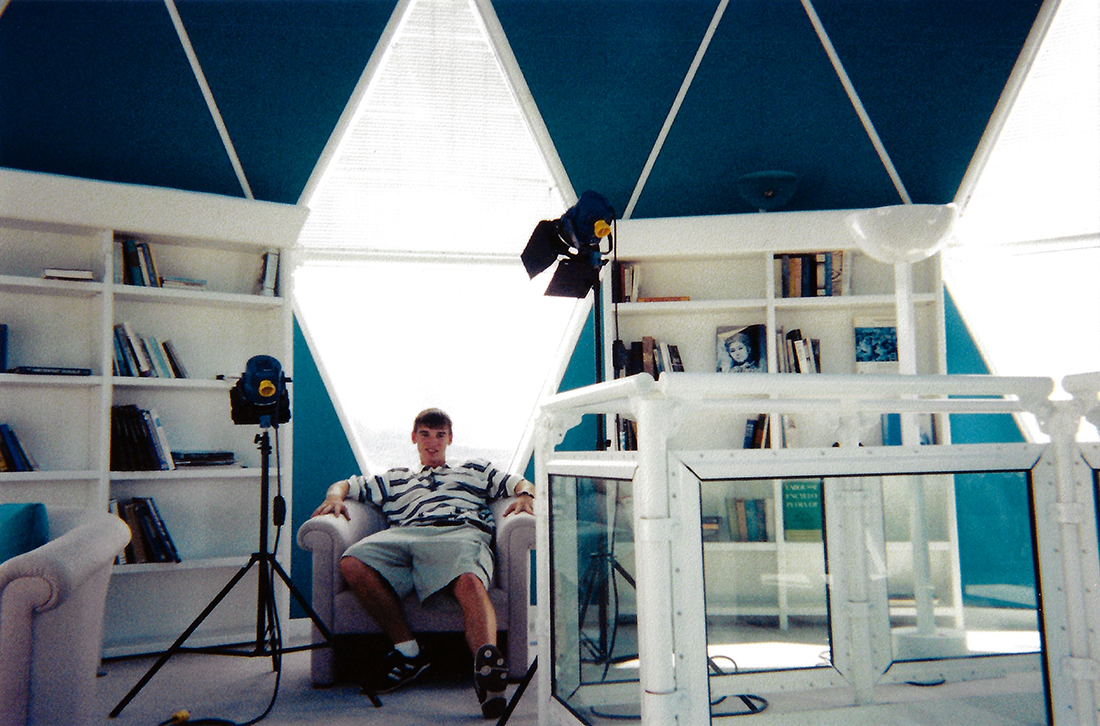
Michael Aaron Gallagher relaxing in the library tower of the Biosphere 2 Center in 1998.
4.1 The Threat to Species Diversity
“Weather prediction is absolutely impossible. The reason is that the behavior of the system is sensitively dependent on initial conditions… tiny differences become amplified… Chaos theory says two things. First, that complex systems like weather have an underlying order. Second, the reverse of that – that simple systems can produce complex behavior.” – Michael Crichton, Jurassic Park
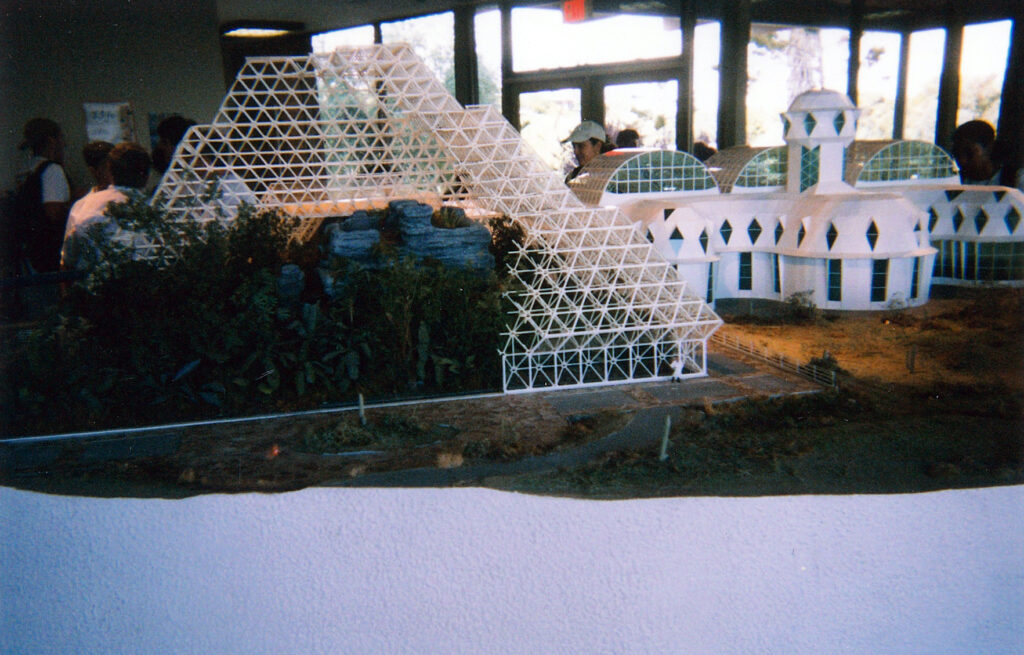
A miniature architectural model of the Biosphere 2 Center in the original Visitor’s Center in 1998.
When we examine the behavior of a natural ecosystem, we can clearly observe the complexity of it, and its reliance on ordinary processes. Likewise, an artificial system no matter how elaborately designed will also be affected by variations in its most fundamental components.
The structure and stability of the Marsh Biome itself relies heavily on the interactions between organisms and the communication channels between it and the larger Biosphere. The attempt to simplify the equation, by reducing the scale of the model and altering the methods by which the regions can interact, did nothing but prove that a simple biological system is capable of finding a way to evolve.
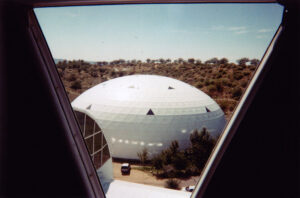
Looking out the window of the library tower of the Biosphere 2 Center at the West Lung, one of the facility’s two lungs. Photograph by Michael Aaron Gallagher, taken in 1998.
The results of the study, along with current information that suggests that the Marsh continues to suffer a significant loss of biodiversity and management neglect, indicate that natural selection has been artificially enhanced. In such cases where populations of organisms are exposed to harsh, unnatural conditions, species extinction is inevitable. The removal of mechanical devices intended to circulate the water between the regions is yet another example of tampering with nature and forcing it to conform.
By removing the artificial circulation mechanisms, the communication between divisions is jeopardized and the harmful effects of poor design and control are enhanced. Consequently, the mangrove estuary is no longer an accurate replica of an authentic wetland.
In order to be successful, the artificial marsh must closely resemble a sub-tropical estuarine ecosystem. Currently, because of the design and maintenance of the system and the lack of species representation the Marsh Biome will continue to implode.
5.0 Future
The stability of an artificial world depends on how closely it resembles a self-sustained, evolving ecosystem. Because the Center is a small-scale replica of several natural habitats, it needs to be closely monitored to ensure that the exaggerated effects of natural processes do not destroy the delicate infrastructure and create a harsh, uninhabitable environment.
For years, scientists have closely monitored the rainforest, ocean and agriculture biomes within the Biosphere 2 Center. Unfortunately, the Marsh continues to be neglected by research teams. Despite the importance of each region to the success of the larger project, the lack of public support, scientific interest, and funding for experiments in the mangrove wetlands have significantly injured the biodiversity within the model.

A view looking up the staircase to the tower of the Biosphere 2 Center (left) and a look through the glass floor from the library at the top to the ground floor below (right). Both photographs were taken by Michael Aaron Gallagher in 1998.
5.1 Management Corrections
Once we have clearly defined the problems with the current model, we can begin to address some of the contributing factors and develop solutions to correct the balance of this delicate infrastructure. By truly understanding the role of outside manipulation and the interaction of organisms and micro-systems within the wetland model, we can solve the decline in biodiversity.
Based on the data, and an analysis of current trends within the Marsh, the following recommendations and current theories are imperative to the improved management of the system.
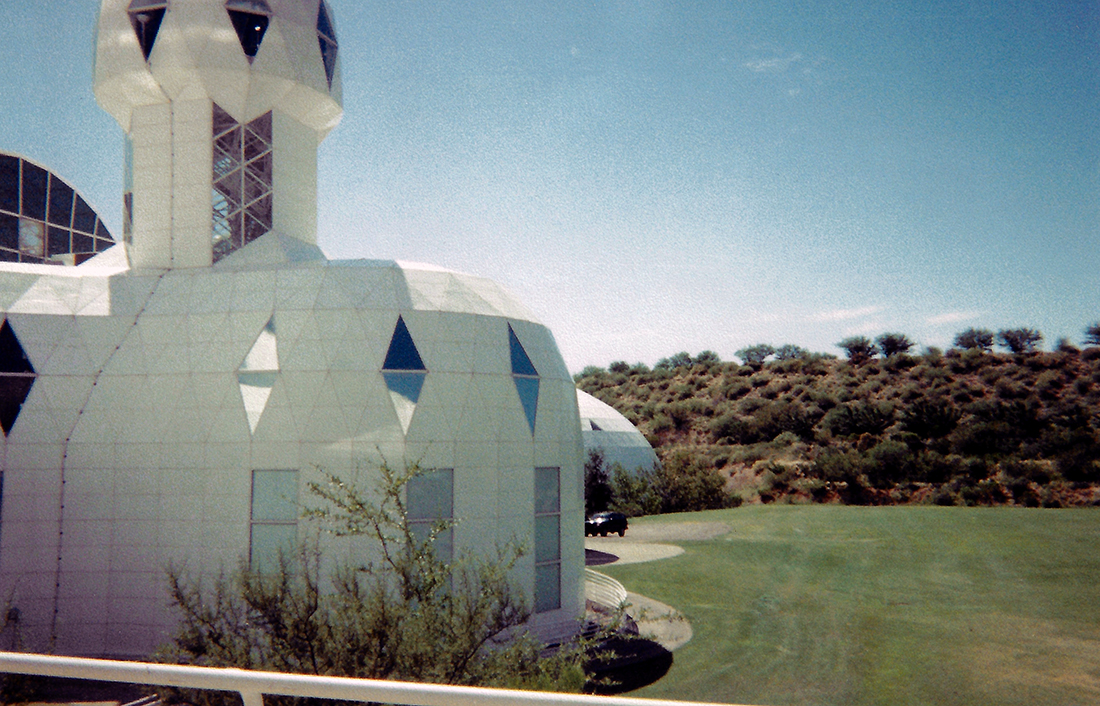
The lawn at The Biosphere 2 Center, taken in 1998. Photo by Michael Aaron Gallagher.
Establishing Control Mechanisms
First, detailed management procedures need to be put into place, including protocols to address instability and extinction. Furthermore, it is important to collect data from this region and allow biome managers to closely monitor and study the Marsh.
Redesigning the System
Second, the model needs to be gradually redesigned and further stabilized. The project should be completed in several phases in order to prevent chaos within the system. The Mangrove Estuary should be purified, removing all statistically significant mutations and preventing the spread of diseases between the existing organisms. Another transplantation of species should be arranged in order to replace the loss of organisms that occurred in the initial phase of the project. The new species implantation should not be as aggressive as the original project, because the data suggests that the size of the Marsh cannot support a biologically cluttered environment. However, it is important that the transplanted organisms fill the gaps in the bioweb and accurately represent life in a natural wetland. A redesign of the physical barriers that separate each of the sections is necessary in order to allow for more natural communication between the regions.
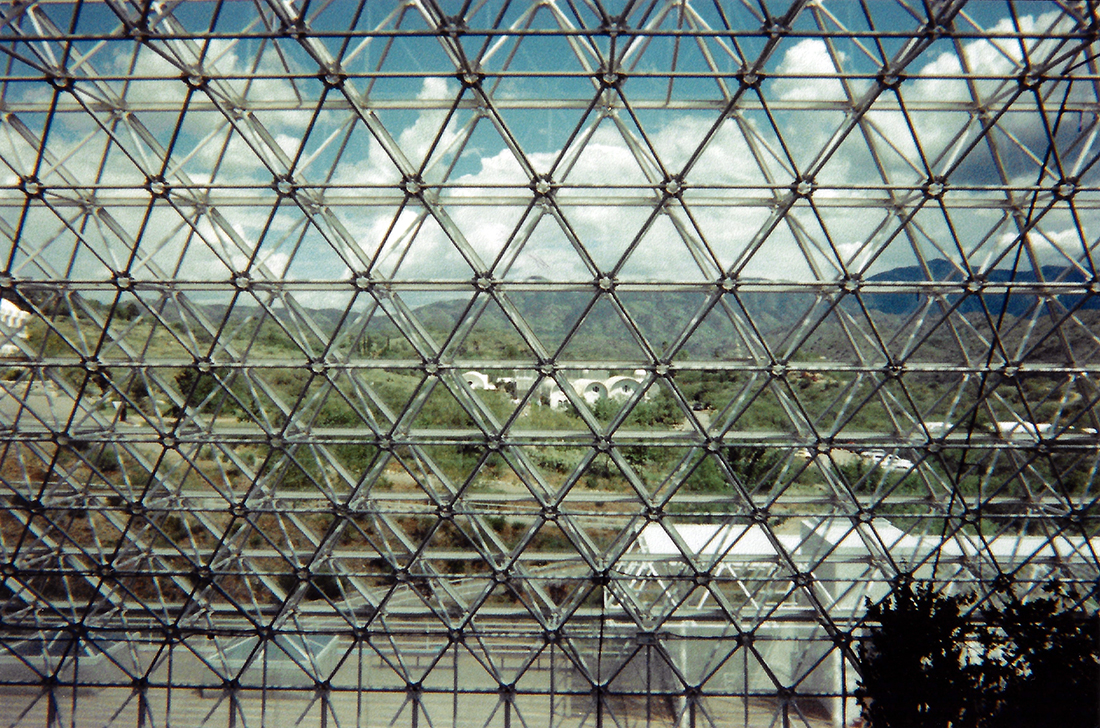
Taken in 1998, before the Biosphere 2 Center was opened to the public for tours, this picture shows the spaceframe with the Santa Catalina mountains in the distance from the inside of the top secret research facility. Photo by Michael Aaron Gallagher.
The Possibilities of Tomorrow
With the right approach, combining integrated management with scientific study, Biome Managers will be able to move from slowing the spread of the problem to eliminating it. The Biosphere 2 Center has the potential to go beyond a functioning, self-sustained system. Perhaps if the individual systems were stabilized, the Center could take on a new role as a haven for endangered life. However, in order for the project to achieve its intended purpose it must first restructure Biomes like the artificial marsh to more closely mimic natural ecosystems. Only then can the Biosphere 2 Center prevent artificial species extinction and the loss of biodiversity within the Marsh.
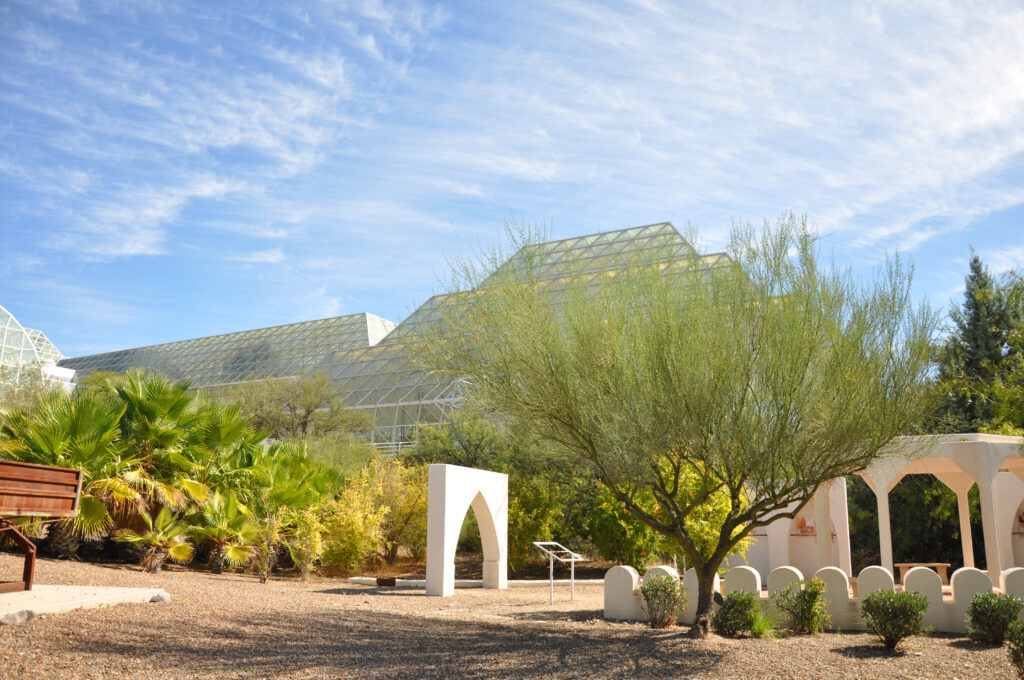
The Bio2 Center Facility. Photo taken by Michael Aaron Gallagher in 2019.
Reactions
From the teacher, Louise Phelps: “Mike made use of research, conducted during an earlier visit to the Biosphere 2 Center, to write this eloquent appeal for restoring biodiversity to the neglected Marsh Biome. He makes effective use of the conventions of white papers to ground his advocacy in a solidly researched, authoritative analysis, featuring crisp organization, effectively chosen visuals, and a document design that is both functional and attractive.”
From the editor, Randall Monty: “Immediate points for throwing conventional essay writing out the window. Or rather, out the environmentally controlled doors. The Biosphere 2 staff could use someone like Gallagher on staff. Who knows, maybe someday we’ll need to grow shellfish on the moon.”

Taken in 1998, this picture shows The Biosphere 2 Center with a cloudy sky above. Photo by Michael Aaron Gallagher.
References
* Biosphere 2 Center Website: Online. <http://www.bio2.edu.2001>
* Crichton, Michael. Jurassic Park. New York. Ballentine Books, 1990.
* Finn, Mathew G. The Marsh Biome of Biosphere 2: Design, Creation and Preliminary Results from an Ecosystem Model. Date Unknown.
* Green, Michael A. et al. Marsh Group Research Data, Presentation, and Paper (Earth Systems Field School Columbia University), 1998.
* Guidelines for Working in Biosphere 2. Biosphere Operations, 1997.
* Hogan, Zeb. Comparative Species Composition and Relative Abundance of the Dominant Vertebrates and Macroinvertebrates in the Aquatic Environments of Biosphere 2, July 1996.
Illustrations and Photography
* Diagram 3.0 – Green, Michael A. et al. Marsh Group Research Data, Presentation, and Paper (Earth Systems Field School Columbia University), 1998.
* Figure 4.0 – Recreated based on actual observations and diagrams from Finn, Mathew G. The Marsh Biome of Biosphere 2: Design, Creation and Preliminary Results from an Ecosystem Model. Date Unknown.
* Additional photography by Michael Aaron Gallagher Copyright 2019 – All rights reserved.
